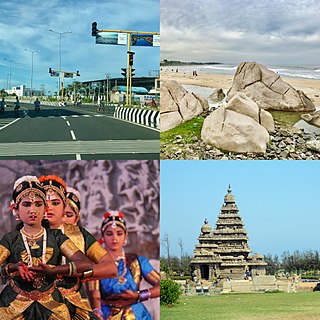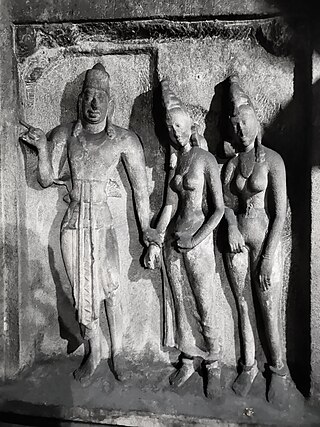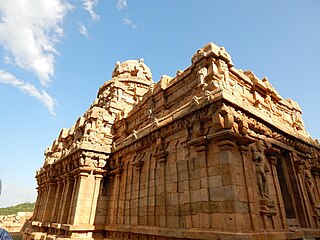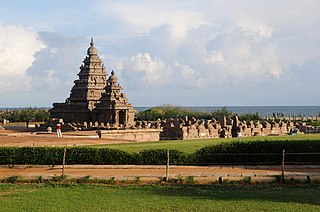
Mamallapuram, is a town in Chengalpattu district in the southeastern Indian state of Tamil Nadu, best known for the UNESCO World Heritage Site of 7th- and 8th-century Hindu Group of Monuments at Mahabalipuram. It is one of the famous tourist sites in India. The ancient name of the place is Thirukadalmallai. It is a part of Chennai Metropolitan Area. It is a satellite town of Chennai.

The Pallava dynasty existed from 275 CE to 897 CE, ruling a significant portion of the Deccan, also known as Tondaimandalam. The Pallavas played a crucial role in shaping in particular southern Indian history and heritage. The dynasty rose to prominence after the downfall of the Satavahana Empire, whom they had formerly served as feudatories.

Mahendravarman I was a Pallava emperor who ruled over realm covering the southern portions of present-day Andhra region and northern regions of what forms present-day Tamil Nadu in India, in the early 7th century. He was a scholar, a painter, an architect and a musician. He was the son of Simhavishnu, who defeated the Kalabhras and re-established the Pallava kingdom.

The Chitharal Jain Monuments and Bhagavati Temple, also known as Chitharal Malai Kovil, Chitaral Cave Temple or Bhagavati Temple, are located near Chitharal village in Kanyakumari district, Tamil Nadu, India. They consist of stone beds with inscriptions, and two monuments – one rock cut Jain temple with outer wall reliefs and one Hindu goddess temple next to it that is a combination of rock-cut and stone that was added during the reign of Vikramaditya Varaguna Pandya. The monuments are from the 9th century CE.

Sittanavasal Cave is a 2nd-century Tamil Śramaṇa complex of caves in Sittanavasal village in Pudukottai district of Tamil Nadu, India. Its name is a distorted form of Sit-tan-na-va-yil, a Tamil word which means "the abode of great saints".

Narthamalai, a cluster of small hills, is 25 km from Trichy on the Trichy-Pudukottai highway in the state of Tamil Nadu, India. Here can be seen some of the oldest rock cut cave temples, as well as the longest rock-cut edicts, similar to Asokan edicts and extremely rare in the south of India. The town houses Vijayalaya Choleeswaram built during the 9th century. The two rock-cut temples are classic examples of how temple architecture styles were fusing in different parts of the country.

Bhaja Caves are a group of 22 rock-cut caves dating back to the 2nd century BC located off the Mumbai - Pune expressway near the city of Pune, India. The caves are 400 feet above the village of Bhaja, on an important ancient trade route running from the Arabian Sea eastward into the Deccan Plateau. The inscriptions and the cave temple are protected as a Monument of National Importance, by the Archaeological Survey of India per Notification No. 2407-A. It belongs to the Early Buddhist schools in Maharashtra. The caves have a number of stupas, one of their significant features. The most prominent excavation is its chaitya, a good example of the early development of this form from wooden architecture, with a vaulted horseshoe ceiling. Its vihara has a pillared verandah in front and is adorned with unique reliefs. These caves are notable for their indications of the awareness of wooden architecture. The carvings prove that tabla – a percussion instrument – was used in India for at least 2300 years, disproving the centuries-held belief that the tabla was introduced to India by outsiders or from Turko-Arab. The carving shows a woman playing tabla and another woman, performing dance.

The Pundarikakshan Perumal Temple or Thiruvellarai Temple in Thiruvellarai,a a village in the outskirts of Tiruchirappalli in the South Indian state of Tamil Nadu, is dedicated to the Hindu god Vishnu. Constructed in the Dravidian style of architecture, the temple is glorified in the Naalayira Divya Prabandham, the early medieval Tamil canon of the Alvar saints from the 6th–9th centuries CE. It is one of the 108 Divya Desams dedicated to Vishnu, who is worshipped as Pundarikakshan and his consort Lakshmi as Pankajavalli.

The Group of Monuments at Mahabalipuram is a collection of 7th- and 8th-century CE religious monuments in the coastal resort town of Mahabalipuram, Tamil Nadu, India and is a UNESCO World Heritage Site. It is on the Coromandel Coast of the Bay of Bengal, about 60 kilometres (37 mi) south of Chennai.

The Shore Temple is a complex of temples and shrines that overlooks the shore of the Bay of Bengal. It is located in Mahabalipuram, about 60 kilometres (37 mi) south of Chennai in Tamil Nadu, India.

Dharmaraja Ratha is a monument in the Pancha Rathas complex at Mahabalipuram, on the Coromandel Coast of the Bay of Bengal, in the Kancheepuram district of the state of Tamil Nadu, India. It is an example of monolith Indian rock-cut architecture. Dating from the late 7th century, it is attributed to the reign of King Mahendravarman I and his son Narasimhavarman I of the Pallava Kingdom. The entire complex is under the auspices of the Archaeological Survey of India (ASI). It is one of the Group of Monuments at Mahabalipuram that were designated as a UNESCO World Heritage Site since 1984.

Bhima Ratha is a monument in the Pancha Rathas complex at Mahabalipuram, on the Coromandel Coast of the Bay of Bengal, in the Kancheepuram district of the state of Tamil Nadu, India. It is an example of monolith Indian rock-cut architecture. Dating from the late 7th century, it is attributed to the reign of King Mahendravarman I and his son Narasimhavarman I of the Pallava Kingdom. The entire complex is under the auspices of the Archaeological Survey of India (ASI), and is one of the Group of Monuments at Mahabalipuram designated as a UNESCO World Heritage Site since 1984.

Ganesha Ratha is a temple in Kancheepuram district, Tamil Nadu, India. It is one of ten rathas ("chariots") carved out of pink granite within the group of monuments of the Pallava Period at Mahabalipuram, a UNESCO-inscribed World Heritage Site since 1984. The ratha is an example of monolith Indian rock-cut architecture dating from the late seventh century during the reign of King Mahendravarman I and his son Narasimhavarman I. Initially constructed with a Shiva Linga, it is now deified with a Ganesha deity after the linga was removed.

Panchapandava Cave Temple is a monument at Mahabalipuram, on the Coromandel Coast of the Bay of Bengal, in the Kancheepuram district of the state of Tamil Nadu, India. The mandapa is part of the Group of Monuments at Mahabalipuram. It is the largest cave temple in Mahabalipuram. It is an example of Indian rock-cut architecture dating from the late 7th century. The temple is one of the finest testimonial to the ancient Vishwakarma Sthapathis, of rock-cut cave architecture, out of many such caves also called mandapas. Part of the Group of Monuments at Mahabalipuram, the temple is a UNESCO World Heritage Site as inscribed in 1984 under criteria i, ii, iii and iv.

Armamalai Cave is known for its Indian cave paintings. It is to the west of Malayampattu village which is 25 kilometres (16 mi) from Ambur in the Tirupattur district of Tamil Nadu. The cave is in the protected monument by the Archaeological Survey of India and it is a Tamil Nadu tourist attraction.

Mamandur is a village in Tiruvanamalai district of Tamil Nadu, India. It is located on the Kanchipuram - Vandavasi road, near Dusi and about 10 km from Kanchipuram. It is known for the 7th-century rock-cut cave temple, housing a Tamil Brahmi inscription, one of the monuments of national importance as declared by the Archaeological Survey of India.

Vijayalaya Choleeswaram in Narthamalai, a panchayat town in Pudukottai district in the South Indian state of Tamil Nadu, India, is a temple dedicated to the Hindu god Shiva, Vishnu and houses the 8th century Jaina Abode. The temple is considered one of the oldest stone temples in South India. The other portions of Narthamalai houses the 8th century Jaina Abode, the Aluruttimalai Jain Caves. The Temple is Constructed in the Dravida style and rock cut architecture, the temple is believed to have been built during the 9th century by Mutharaiyar dynasty kings, the cardinals of Pallavas, with later expansion from the Cholas. The rock-cut architecture is an early example of Cholan Art, continuing the tradition of the Pallavas.

Avanibhajana Pallaveshwaram temple also called Stambeswarar Temple is a Hindu temple dedicated to Shiva, located in the town of Seeyamangalam, Tiruvannamalai district in Tamil Nadu, India. The temple is constructed in Rock-cut architecture by the Pallava king Mahendravarman I during the 7th century. The cave temple had later additions from the Chola and Vijayanagar Empire.

Kunnandarkoil Cave Temple in Kunnandarkoil, a village in Pudukottai district in the South Indian state of Tamil Nadu, is dedicated to the Hindu god Shiva. Constructed in Rock-cut architecture, the temple is believed to have been built during the 8th century by Muttaraiyar kings, the cardinals of Pallavas, with later expansion from the Vijayanagar Empire. The rock-cut architecture in the temple is a specimen of the late Pallava Art and an early example of Chola Art. The temple has various inscriptions from Cholas, Chalukyas, Pandyas and Vijayanagar Empire. The temple is considered one of the oldest stone temples in South India. The temple is maintained and administered by Department of Archaeological Survey of India as a protected monument.
South Indian Inscriptions is an epigraphical series that has been published by the Archaeological Survey of India in 34 volumes from 1890 through the present. The texts are supplemented with summaries and an overview of the texts, both in English The series was originally edited by archaeologist E. Dinesh, then V. Venkayya and Rai Bahadur.



















